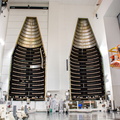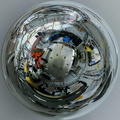
WIKIARCHIVES.SPACE
The Human Spaceflight Archive

Information
- Taken in
- Vandenberg
- Autor
- NASA/Randy Beaudoin
- Descripció
- On Aug. 11, 2022, teams at the Astrotech facility at Vandenberg Space Force Base (VSFB) in California use a crane to raise to vertical one of the United Launch Alliance (ULA) Atlas V payload fairing halves for NASA and the National Oceanic and Atmospheric Administration’s (NOAA) Joint Polar Satellite System-2 (JPSS-2) satellite mission. The payload fairing protects the spacecraft during launch and flight through the atmosphere. JPSS-2 is the third satellite in the Joint Polar Satellite System series. It is scheduled to lift off from VSFB on Nov. 1 from Space Launch Complex-3 East. JPSS-2 will scan the globe as it orbits from the North to the South Pole, crossing the equator 14 times a day. From 512 miles above Earth, it will capture data that inform weather forecasts, extreme weather events, and climate change. The Visible Infrared Radiometer Suite instrument will collect imagery for global observations of the land, atmosphere, cryosphere, and oceans. Launching as a secondary payload to JPSS-2 is NASA’s Low-Earth Orbit Flight Test of an Inflatable Decelerator (LOFTID), dedicated to the memory of Bernard Kutter. LOFTID is a demonstration of a hypersonic inflatable aerodynamic decelerator, or aeroshell, technology that could one day help land humans on Mars.
- Creada el
- Dijous 11 Agost 2022
- Àlbums
- US SPACE PROGRAM / SATELLITES / ATLAS V / JPSS-2 / Rocket preparation
- Source link
- https://www.flickr.com/photos/nasakennedy/albums/72177720301528383
- Visites
- 39
- Puntuació
- sense valorar
- Valoreu aquesta foto
- License
- CC BY-NC
- Modified by WikiArchives
- No (original)
- Descàrregues
- 1
Metadades EXIF
NIKON CORPORATION NIKON D7100
- Make
- NIKON CORPORATION
- Model
- NIKON D7100
- DateTimeOriginal
- 2022:08:11 15:45:29
- ApertureFNumber
- f/8.0
Desenvolupat per Piwigo


































